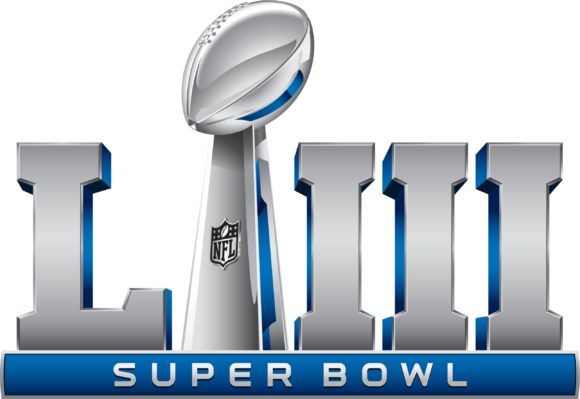Perhaps you’ve heard. On Feb. 3, the New England Patriots will face off against the Los Angeles Rams in the Super Bowl in Mercedes-Benz Stadium in Atlanta. There has been a little bit about it on television and online. The good people at Harvard Kennedy School’s Shorenstein Center and the Carnegie-Knight Initiative felt the reporting did not go far enough so they went scouting for some new research related to this major event. Here are two studies they found.
“Sentiment and Stock Returns: Anticipating a Major Sporting Event”
Payne, Brian C.; Tresl, Jiri; Friesen, Geoffrey C. Journal of Sports Economics, 2018.
This study looks at stock returns before and after the Super Bowl for firms headquartered in the qualifying teams’ states. “The hypotheses in our article are motivated by three connected empirical findings,” the authors write. “That sporting events affect mood, that mood affects investor behavior, and that investor behavior can affect stock prices. We are particularly interested in the interplay between mood and the ‘anticipation’ of a future event.” The study looks at individual firms’ stock returns for Super Bowls occurring between 1967 and 2010.
Key findings:
- The researchers found “significantly positive abnormal returns in local stocks prior to the Super Bowl.” The authors write, “These abnormal returns are larger than those that occur after the Super Bowl, and they occur for firms associated with both competing teams.” They link these returns to an “anticipatory ‘euphoria’ among investors.”
- Favored teams that won had significant, positive postgame returns; favored teams that lost had negative postgame returns; and nonfavored teams had neutral or negative postgame returns regardless of whether they won or lost.
- In the mood for some legal betting? “The data suggest a viable trading strategy around the Super Bowl involving a zero net investment portfolio consisting of a long position in all firms headquartered in competing teams’ states and a short position in the S&P 500. Such a strategy has yielded an average return of 3.01 percent across the 19 trading-day window and has been profitable in 33 of the 42 years.”
“Success Is Something to Sneeze At: Influenza Mortality in Cities That Participate in the Super Bowl”
Stoecker, Charles; Sanders, Nicholas J.; Barreca, Alan. American Journal of Health Economics, 2016.
The Super Bowl brings together spectators and hosts at gatherings across the country. These spectators play host as well — to a number of bacteria and viruses that transmit disease. This study looks at influenza mortality rates from 1974 to 2009 in counties with teams participating in the Super Bowl compared with the home counties of teams that didn’t make it to the big game that year.
Key findings:
- There were no changes in influenza mortality for host cities of the Super Bowl. However, “a local team making it to the Super Bowl increases influenza mortality in the participating county.”
- Counties that sent a team to the super bowl reported an additional seven reported influenza deaths per million among people aged 65 and older — an 18 percent increase compared to the average. And in years where influenza strains are more virulent, or when Super Bowl season and peak influenza season overlap, the effects are more pronounced.
- “If a major contributor to increased influenza spread is local gatherings for watching games, a simple policy solution is to increase awareness of influenza transmission vectors during times of sports-related gatherings. Reminding people to wash their hands and avoid sharing drinks or food at parties during the height of influenza season, especially if they have high amounts of contact with vulnerable populations, could have large social returns,” the authors conclude.
Source: Harvard Kennedy School’s Shorenstein Center and the Carnegie-Knight Initiative
And for any insurance carriers out there planning television ads to air during the Super Bowl, this one’s for you from the University of Georgia.
The result of football instant replay video reviews can alter a consumer’s perception of a brand, according to a study conducted by researchers at the University of Georgia Grady College of Journalism and Mass Communication. The upcoming Super Bowl, often referred to as the “Ad Bowl,” provides a variety of advertising opportunities, including when officials pause game action to analyze an instant replay video.
A pair of Grady College researchers have linked the outcomes of those football replay reviews to consumers having a positive perception of a brand. Jihoon “Jay” Kim, a doctoral student at Grady College, and Jooyoung Kim, an associate professor of advertising, investigated how the use of advertising in sporting events’ replay review affected consumer feelings toward sponsored brands.
“I watched a tennis game one day and saw the replay system,” Jay Kim said. “While the video was reviewed live, I saw a brand logo on the screen and thought it was interesting because two groups of fans were watching it; the result of the replay video would make one group happy and the other group unhappy.”
To untap this psychological phenomenon, they researched the concept of “schadenfreude,” a German word for the experience of joy when observing another’s misfortune, or in this case, the joy fans have when a referee makes a call that helps their team and hurts the opponent. “An advertisement used correctly can have a positive emotional transfer to a consumer,” Jooyoung Kim said. “A traditional view is that attitudes toward advertising leads to attitudes toward the brand, which then drives consumer behavior.”
Jay Kim and Jooyoung Kim developed an online experiment where nearly 400 students watched brand-sponsored instant replay videos in college football games. Participants were then asked a series of questions based on the result of the replay review. The study measured responses in four game situations varied by the caliber of rivalry and level of suspense: rivalry games, non-rivalry games, suspenseful games and non-suspenseful games.
Results showed increased focus and attention from spectators during rivalry games and during suspenseful moments. Also, spectators felt a greater amount of positive emotion when a referee’s decision through an instant replay video benefited their team late in a game with a close score compared to a less suspense-filled moment.
Jooyoung Kim said the results of this study could lead to a series of exciting advancements for advertisers of sporting events. “Advertisers want to be present at the place where their audiences are happy rather than mad. They want to be associated with the positive memory,” Jooyoung Kim said.
According to Jooyoung Kim, in the past it was not possible to understand an audience down to the individual level. Individual targeting is becoming possible because of the technological advances. Programming systems will be able to use algorithms to choose whether to show a certain brand logo to a specific fan watching the game. The typical broadcast delay of approximately seven seconds for live-streaming sporting events will enable marketers to tailor the brand logo to match the happy fan.
“In an international competition such as FIFA World Cup or the Wimbledon Championships, sponsoring brands could use geographical information to decide whether their ads should be used with an IRV based on whether the outcome benefits a particular team or player. This would need a lot of coordination among the sponsors, media, and the sporting event hosts,” Jay Kim added.
Future research will focus on schadenfreude’s inverse concept, gluckschmerz, or feeling unhappy about the good fortune of others. “Both concepts show how morally weak humans can be in social settings: we like when our opponent fails and don’t like when the opponent succeeds. But that’s the reality of being human, and the marketers can seize this untapped opportunity for their brands,” Jooyoung Kim said.
Topics Education Universities
Was this article valuable?
Here are more articles you may enjoy.



 Board Calls for US Steel to Address Safety Issues as It Rebuilds Site of Fatal Explosion
Board Calls for US Steel to Address Safety Issues as It Rebuilds Site of Fatal Explosion  Longtime Motel 6 Spokesman Tom Bodett Settles Lawsuit Against Chain
Longtime Motel 6 Spokesman Tom Bodett Settles Lawsuit Against Chain  Three Top P/C Insurers Account for Most of Insurance AI Patents
Three Top P/C Insurers Account for Most of Insurance AI Patents  Judge Green Lights New York’s Driver’s License Law, Rejecting Trump Challenge
Judge Green Lights New York’s Driver’s License Law, Rejecting Trump Challenge 

